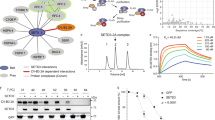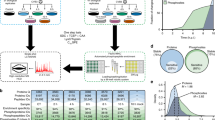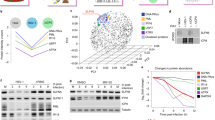Abstract
Enteroviruses (EVs) comprise a large genus of positive-sense, single-stranded RNA viruses whose members cause a number of important and widespread human diseases, including poliomyelitis, myocarditis, acute flaccid myelitis and the common cold. How EVs co-opt cellular functions to promote replication and spread is incompletely understood. Here, using genome-scale CRISPR screens, we identify the actin histidine methyltransferase SET domain containing 3 (SETD3) as critically important for viral infection by a broad panel of EVs, including rhinoviruses and non-polio EVs increasingly linked to severe neurological disease such as acute flaccid myelitis (EV-D68) and viral encephalitis (EV-A71). We show that cytosolic SETD3, independent of its methylation activity, is required for the RNA replication step in the viral life cycle. Using quantitative affinity purification–mass spectrometry, we show that SETD3 specifically interacts with the viral 2A protease of multiple enteroviral species, and we map the residues in 2A that mediate this interaction. 2A mutants that retain protease activity but are unable to interact with SETD3 are severely compromised in RNA replication. These data suggest a role of the viral 2A protein in RNA replication beyond facilitating proteolytic cleavage. Finally, we show that SETD3 is essential for in vivo replication and pathogenesis in multiple mouse models for EV infection, including CV-A10, EV-A71 and EV-D68. Our results reveal a crucial role of a host protein in viral pathogenesis, and suggest targeting SETD3 as a potential mechanism for controlling viral infections.
This is a preview of subscription content, access via your institution
Access options
Access Nature and 54 other Nature Portfolio journals
Get Nature+, our best-value online-access subscription
$29.99 / 30 days
cancel any time
Subscribe to this journal
Receive 12 digital issues and online access to articles
$119.00 per year
only $9.92 per issue
Buy this article
- Purchase on Springer Link
- Instant access to full article PDF
Prices may be subject to local taxes which are calculated during checkout





Similar content being viewed by others
Data availability
Raw deep-sequencing data corresponding to the CRISPR KO screens reported in this paper are deposited in ArrayExpress (https://www.ebi.ac.uk/arrayexpress/) with accession number E-MTAB-8125.
References
Kaufmann, S. H. E., Dorhoi, A., Hotchkiss, R. S. & Bartenschlager, R. Host-directed therapies for bacterial and viral infections. Nat. Rev. Drug Discov. 17, 35–56 (2018).
Bramley, T. J., Lerner, D. & Sames, M. Productivity losses related to the common cold. J. Occup. Environ. Med. 44, 822–829 (2002).
Castillo, J. R., Peters, S. P. & Busse, W. W. Asthma exacerbations: pathogenesis, prevention, and treatment. J. Allergy Clin. Immunol. Pract. 5, 918–927 (2017).
Palmenberg, A. C. et al. Sequencing and analyses of all known human rhinovirus genomes reveal structure and evolution. Science 324, 55–59 (2009).
Cassidy, H., Poelman, R., Knoester, M., Van Leer-Buter, C. C. & Niesters, H. G. M. Enterovirus D68—the new polio? Front. Microbiol. 9, 2677 (2018).
Bochkov, Y. A. et al. Cadherin-related family member 3, a childhood asthma susceptibility gene product, mediates rhinovirus C binding and replication. Proc. Natl Acad. Sci. USA 112, 5485–5490 (2015).
Shalem, O. et al. Genome-scale CRISPR–Cas9 knockout screening in human cells. Science 343, 84–87 (2014).
Li, W. et al. MAGeCK enables robust identification of essential genes from genome-scale CRISPR/Cas9 knockout screens. Genome Biol. 15, 554 (2014).
Liu, Y. et al. Sialic acid-dependent cell entry of human enterovirus D68. Nat. Commun. 6, 8865 (2015).
Hunt, S. L., Hsuan, J. J., Totty, N. & Jackson, R. J. unr, a cellular cytoplasmic RNA-binding protein with five cold-shock domains, is required for internal initiation of translation of human rhinovirus RNA. Genes Dev. 13, 437–448 (1999).
Staring, J. et al. PLA2G16 represents a switch between entry and clearance of Picornaviridae. Nature 541, 412–416 (2017).
Wilkinson, A. W. et al. SETD3 is an actin histidine methyltransferase that prevents primary dystocia. Nature 565, 372–376 (2019).
Kwiatkowski, S. et al. SETD3 protein is the actin-specific histidine N-methyltransferase. eLife 7, e37921 (2018).
Messacar, K. et al. Enterovirus D68 and acute flaccid myelitis-evaluating the evidence for causality. Lancet Infect. Dis. 18, e239–e247 (2018).
Chen, K. et al. Methyltransferase SETD2-mediated methylation of STAT1 is critical for interferon antiviral activity. Cell 170, 492–506 (2017).
Wang, C. et al. The methyltransferase NSD3 promotes antiviral innate immunity via direct lysine methylation of IRF3. J. Exp. Med. 214, 3597–3610 (2017).
Lamphear, B. J. et al. Mapping the cleavage site in protein synthesis initiation factor eIF-4γ of the 2A proteases from human coxsackievirus and rhinovirus. J. Biol. Chem. 268, 19200–19203 (1993).
Verschueren, E. et al. Scoring large-scale affinity purification mass spectrometry datasets with MiST. Curr. Protoc. Bioinformatics 49, 11–16 (2015).
Watters, K. & Palmenberg, A. C. Differential processing of nuclear pore complex proteins by rhinovirus 2A proteases from different species and serotypes. J. Virol. 85, 10874–10883 (2011).
Ventoso, I., MacMillan, S. E., Hershey, J. W. & Carrasco, L. Poliovirus 2A proteinase cleaves directly the eIF-4G subunit of eIF-4F complex. FEBS Lett. 435, 79–83 (1998).
Greninger, A. L., Knudsen, G. M., Betegon, M., Burlingame, A. L. & Derisi, J. L. The 3A protein from multiple picornaviruses utilizes the golgi adaptor protein ACBD3 to recruit PI4KIIIβ. J. Virol. 86, 3605–3616 (2012).
Wessels, E. et al. A viral protein that blocks Arf1-mediated COP-I assembly by inhibiting the guanine nucleotide exchange factor GBF1. Dev. Cell 11, 191–201 (2006).
Torres, J. Z., Miller, J. J. & Jackson, P. K. High-throughput generation of tagged stable cell lines for proteomic analysis. Proteomics 9, 2888–2891 (2009).
Petersen, J. F. et al. The structure of the 2A proteinase from a common cold virus: a proteinase responsible for the shut-off of host-cell protein synthesis. EMBO J. 18, 5463–5475 (1999).
Yu, S. F. & Lloyd, R. E. Characterization of the roles of conserved cysteine and histidine residues in poliovirus 2A protease. Virology 186, 725–735 (1992).
Dickinson, M. E. et al. High-throughput discovery of novel developmental phenotypes. Nature 537, 508–514 (2016).
Huang, P. N. & Shih, S. R. Update on enterovirus 71 infection. Curr. Opin. Virol. 5, 98–104 (2014).
Li, S. et al. A neonatal mouse model of coxsackievirus A10 infection for anti-viral evaluation. Antivir. Res. 144, 247–255 (2017).
Huang, S. W., Wang, Y. F., Yu, C. K., Su, I. J. & Wang, J. R. Mutations in VP2 and VP1 capsid proteins increase infectivity and mouse lethality of enterovirus 71 by virus binding and RNA accumulation enhancement. Virology 422, 132–143 (2012).
Hambidge, S. J. & Sarnow, P. Translational enhancement of the poliovirus 5′ noncoding region mediated by virus-encoded polypeptide 2A. Proc. Natl Acad. Sci. USA 89, 10272–10276 (1992).
Li, X., Lu, H. H., Mueller, S. & Wimmer, E. The C-terminal residues of poliovirus proteinase 2Apro are critical for viral RNA replication but not for cis- or trans-proteolytic cleavage. J. Gen. Virol. 82, 397–408 (2001).
Lloyd, R. E., Grubman, M. J. & Ehrenfeld, E. Relationship of p220 cleavage during picornavirus infection to 2A proteinase sequencing. J. Virol. 62, 4216–4223 (1988).
Ryan, M. D. & Flint, M. Virus-encoded proteinases of the picornavirus super-group. J. Gen. Virol. 78, 699–723 (1997).
Hoshii, T. et al. A non-catalytic function of SETD1A regulates cyclin K and the DNA damage response. Cell 172, 1007–1021 (2018).
Lai, A. C. & Crews, C. M. Induced protein degradation: an emerging drug discovery paradigm. Nat. Rev. Drug Discov. 16, 101–114 (2017).
Lanke, K. H. et al. GBF1, a guanine nucleotide exchange factor for Arf, is crucial for coxsackievirus B3 RNA replication. J. Virol. 83, 11940–11949 (2009).
Bochkov, Y. A. et al. Molecular modeling, organ culture and reverse genetics for a newly identified human rhinovirus C. Nat. Med. 17, 627–632 (2011).
Sanjana, N. E., Shalem, O. & Zhang, F. Improved vectors and genome-wide libraries for CRISPR screening. Nat. Methods 11, 783–784 (2014).
Marceau, C. D. et al. Genetic dissection of flaviviridae host factors through genome-scale CRISPR screens. Nature 535, 159–163 (2016).
Verstrepen, W. A., Kuhn, S., Kockx, M. M., Van De Vyvere, M. E. & Mertens, A. H. Rapid detection of enterovirus RNA in cerebrospinal fluid specimens with a novel single-tube real-time reverse transcription-PCR assay. J. Clin. Microbiol. 39, 4093–4096 (2001).
Bragstad, K. et al. High frequency of enterovirus D68 in children hospitalised with respiratory illness in Norway, autumn 2014. Influenza Other Resp. Viruses 9, 59–63 (2015).
McKnight, K. L. & Lemon, S. M. Capsid coding sequence is required for efficient replication of human rhinovirus 14 RNA. J. Virol. 70, 1941–1952 (1996).
Ding, S. et al. Comparative proteomics reveals strain-specific β-TrCP degradation via rotavirus NSP1 hijacking a host Cullin-3-Rbx1 complex. PLoS Pathog. 12, e1005929 (2016).
Cox, J. & Mann, M. MaxQuant enables high peptide identification rates, individualized p.p.b.-range mass accuracies and proteome-wide protein quantification. Nat. Biotechnol. 26, 1367–1372 (2008).
Kron, S. J., Drubin, D. G., Botstein, D. & Spudich, J. A. Yeast actin filaments display ATP-dependent sliding movement over surfaces coated with rabbit muscle myosin. Proc. Natl Acad. Sci. USA 89, 4466–4470 (1992).
Schafer, D. A., Jennings, P. B. & Cooper, J. A. Rapid and efficient purification of actin from nonmuscle sources. Cell Motil. Cytoskeleton 39, 166–171 (1998).
Ramage, H. R. et al. A combined proteomics/genomics approach links hepatitis C virus infection with nonsense-mediated mRNA decay. Mol. Cell 57, 329–340 (2015).
Clauser, K. R., Baker, P. & Burlingame, A. L. Role of accurate mass measurement (±10 ppm) in protein identification strategies employing MS or MS/MS and database searching. Anal. Chem. 71, 2871–2882 (1999).
Duke, G. M., Hoffman, M. A. & Palmenberg, A. C. Sequence and structural elements that contribute to efficient encephalomyocarditis virus RNA translation. J. Virol. 66, 1602–1609 (1992).
Jager, S. et al. Global landscape of HIV–human protein complexes. Nature 481, 365–370 (2011).
Jager, S. et al. Purification and characterization of HIV–human protein complexes. Methods 53, 13–19 (2011).
MacLean, B. et al. Skyline: an open source document editor for creating and analyzing targeted proteomics experiments. Bioinformatica 26, 966–968 (2010).
Choi, M. et al. MSstats: an R package for statistical analysis of quantitative mass spectrometry-based proteomic experiments. Bioinformatica 30, 2524–2526 (2014).
Watters, K. et al. Differential disruption of nucleocytoplasmic trafficking pathways by rhinovirus 2A proteases. J. Virol. 91, e02472–16 (2017).
National Research Council. Guide for the Care and Use of Laboratory Animals 8th edn (National Academies Press, 2010).
U.S. Department of Health and Human Services National Institutes of Health. Public Health Service Policy on Humane Care and Use of Laboratory Animals (Office of Laboratory Animal Welfare, 2015).
Mao, Q. et al. A neonatal mouse model of coxsackievirus A16 for vaccine evaluation. J. Virol. 86, 11967–11976 (2012).
Bradley, A. et al. The mammalian gene function resource: the International Knockout Mouse Consortium. Mamm. Genome 23, 580–586 (2012).
Li, J. & Daly, T. M. Adeno-associated virus-mediated gene transfer to the neonatal brain. Methods 28, 203–207 (2002).
Hixon, A. M. et al. A mouse model of paralytic myelitis caused by enterovirus D68. PLoS Pathog. 13, e1006199 (2017).
Acknowledgements
The authors thank the Carette Laboratory members for intellectual discussions and support. We acknowledge C. Marceau (Chan Zuckerberg Biohub) and A. Puschnik (Chan Zuckerberg Biohub) for invaluable advice and technical assistance. We thank K. Kirkegaard (Stanford University), M. Holtzman (Washington University School of Medicine in St. Louis), A. Palmenberg (University of Wisconsin-Madison) and K. Shokat (University of California San Francisco) for helpful discussions and valuable advice. We express our gratitude to the Stanford Shared FACS Facility and its former director M. Bigos, the Stanford Functional Genomics Facility and X. Ji, the Stanford University Mass Spectrometry Core and the Stanford Network Analysis of Proteins team under the guidance of P. Jackson, the Stanford Protein and Nucleic Acid Facility and the Stanford Mouse Facility for excellent services and professional technical assistance. We thank V. Masto for technical assistance with cloning, and M. Shales for assistance preparing figures related to the mass spectrometry data. We acknowledge the NIH Biodefense and Emerging Infections Research Repository (BEI Resources), NIAID, NIH for providing multiple viruses mentioned in the Methods. We thank J.-R. Wang (National Cheng Kung University, Taiwan) for providing the EV-A71 (MP4) infectious clone. This work was funded in part by the NSF GRFP (J.D.), Stanford Graduate Fellowship (J.D.), American Asthma Foundation 2014 Scholar Award (J.E.C.), NIH DP2 AI104557 (J.E.C.), NIH U19 AI109662 (J.E.C.), NIH R01 AI140186 (J.E.C.), Stanford Dean’s Fellowship (Y.S.O.), David and Lucile Packard Foundation (J.E.C.), NIH R01 GM079641 (O.G.), NIH R01 GM133051 (O.G.), NIH P01-AI091575 (R.A. and N.J.K.), NIH P50-GM082250 (N.J.K.), NIH P50-GM081879 (N.J.K.), NIH U19-AI135990 (N.J.K.), NIH R01 AI021362 (H.B.G.), NIH R56 AI021362 (H.B.G.), VA Merit review grant GRH0022 (H.B.G.), NIH K99 AI135031 (S.D.), Stanford Maternal and Child Health Research Institute (S.D.) and Thrasher Research Fund Early Career Award (S.D.).
Author information
Authors and Affiliations
Contributions
J.D., Y.S.O. and A.W.W. were responsible for design and execution of the experiments, data analysis and manuscript preparation. C.E.P. analysed and generated the phylogenetic tree of SET domain family members, performed the CV-B3 2A alanine scan and analysed the three-dimensional structure of SETD3-binding mutants of 2A. E.F., J.R.J., O.L., G.J., T.Y., E.V., R.A. and N.J.K. designed, collected and analysed the CV-B3 virus–host interaction proteomics data. A.W.W. performed and analysed the actin methylation mass spectrometry experiments with help from J.E.E. J.Z. performed the statistical analyses for all datasets, and cloned and analysed the GFP-ΔVP1-2A constructs and CV-B3 infectious clones that harbour SETD3-binding mutants of 2A. R.H., G.J., J.X. and N.J.K. designed, collected and analysed the multiple EVs’ 2A AP-MS datasets. C.M.N., K.-F.W., J.D., K.J.K. and P.S. were responsible for the in vivo mice experiments and analysis. S.D. and H.B.G. were responsible for examining innate immune responses and expression levels of IFN-stimulated gene by transcriptome-wide RNA-Seq. J.E.C., O.G., N.J.K. and R.A. supervised the research, interpreted the data and prepared the manuscript.
Corresponding authors
Ethics declarations
Competing interests
O.G. is a co-founder of EpiCypher and Athelas Therapeutics.
Additional information
Publisher’s note Springer Nature remains neutral with regard to jurisdictional claims in published maps and institutional affiliations.
Supplementary information
Supplementary Information
Supplementary Figs. 1–21 and Supplementary Table legends.
Supplementary Table 1
Datasets of RV-C15 and EV-D68 CRISPR screens.
Supplementary Table 2
RNA-Seq of WT versus SETD3KO cells.
Supplementary Table 3
AP-MS of SETD3 pull-downs.
Supplementary Table 4
AP-MS of CV-B3 viral proteins pull-downs.
Supplementary Table 5
AP-MS of multiple EV 2A pull-downs.
Supplementary Table 6
Precise P values for statistical analyses.
Rights and permissions
About this article
Cite this article
Diep, J., Ooi, Y.S., Wilkinson, A.W. et al. Enterovirus pathogenesis requires the host methyltransferase SETD3. Nat Microbiol 4, 2523–2537 (2019). https://doi.org/10.1038/s41564-019-0551-1
Received:
Accepted:
Published:
Issue Date:
DOI: https://doi.org/10.1038/s41564-019-0551-1
This article is cited by
-
Proteomic and genetic analyses of influenza A viruses identify pan-viral host targets
Nature Communications (2023)
-
Structure-function analysis of enterovirus protease 2A in complex with its essential host factor SETD3
Nature Communications (2022)
-
Stabilization of SETD3 by deubiquitinase USP27 enhances cell proliferation and hepatocellular carcinoma progression
Cellular and Molecular Life Sciences (2022)
-
Surfaceome CRISPR screen identifies OLFML3 as a rhinovirus-inducible IFN antagonist
Genome Biology (2021)
-
SETD3 Downregulation Mediates PTEN Upregulation-Induced Ischemic Neuronal Death Through Suppression of Actin Polymerization and Mitochondrial Function
Molecular Neurobiology (2021)



